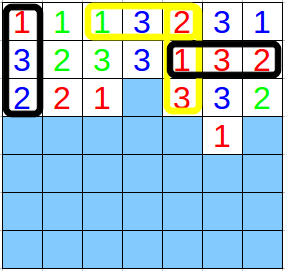The Wiki for Tale 4 is in read-only mode and is available for archival and reference purposes only. Please visit the current Tale 11 Wiki in the meantime.
If you have any issues with this Wiki, please post in #wiki-editing on Discord or contact Brad in-game.
Difference between revisions of "User:Numaris/Thought Monument Test"
| Line 20: | Line 20: | ||
If all of these conditions hold true, the estate owner (player) may remove them from the board, and the rising waters will force the blocks in the affected columns to move up to fill the vacated space. If a column in the middle of the board is left empty, all the blocks on one side or the other move over to close the gap. | If all of these conditions hold true, the estate owner (player) may remove them from the board, and the rising waters will force the blocks in the affected columns to move up to fill the vacated space. If a column in the middle of the board is left empty, all the blocks on one side or the other move over to close the gap. | ||
| + | |||
| + | The game is won when all blocks are removed from the board, and lost if the board is left in a state in which no legal moves remain. | ||
=== Example === | === Example === | ||
Revision as of 02:15, 8 July 2010
Test of the Hastened Harvest
This is a description of a test to consider for inclusion on the Tale 4 Monument of Thought. Suggestions and general discussion are encouraged. Please use the Discussion page, rather than directly editing this page.
Summary
Hapi has been displeased!
The Nile is flooding rapidly under the god's wrath. Though the crops have been harvested, they have not yet been hauled in off the banks of the river. It's up to the estate owner to direct his itinerant workers to get the grain off the flood plain before it washes away.
The game board consists of a 2-dimensional square (or rectangular) grid filled with blocks representing workers. The top of the board represents the open land, and the bottom represents the encroaching water. Each worker block has two traits: role (represented by a heiroglyph on the block) and tribe (represented by the color of the heiroglyph). There are three roles (foreman, loader, hauler), and three tribes (red, blue, green). The object is to remove all blocks from the board in sets of three. Three blocks can be removed only if all of the following are true:
- The blocks are adjacent and aligned horizontally or vertically (in a line, no L-shapes).
- At least one of the blocks touches the top of the board.
- All three blocks are either all the same tribe, or all different tribes. If two are from one tribe, and the third from another, the two will conspire against the third to keep a larger share of the pay.
- All three blocks are either all the same role, or all different roles. Three of the same role can agree amongst themselves to share the duties, but two will simply bicker incessantly.
If all of these conditions hold true, the estate owner (player) may remove them from the board, and the rising waters will force the blocks in the affected columns to move up to fill the vacated space. If a column in the middle of the board is left empty, all the blocks on one side or the other move over to close the gap.
The game is won when all blocks are removed from the board, and lost if the board is left in a state in which no legal moves remain.
Example
In this example, numbers are used in place of hieroglyphs. The vertical group outlined in black on the left would *not* be a valid grouping, since 2 blocks are of the blue tribe, and the third is red. The horizontal group outlined in black is also not valid, since it does not touch the top of the board. Either of the two groups outlined in yellow would be valid moves.
Technical Notes
- Recommended board size is 7x7. A minimum number of blocks (maybe 21?) should be required, but the board need not be full (and in fact can not be, since there must be a multiple of three blocks.
- Since a block may be part of more than one possible grouping, there must be a way to unambiguously select the line of three blocks.
- It can be designed like most other Thought puzzles, which is to say that once the layout is finalized, the designer must solve it before it can be opened for general play.
- In the design interface, it would be very useful if the designer could push rows/columns of blocks around so that they can work backwards.
- Since there are only 9 different possible blocks, there will be duplicates.
